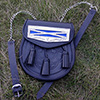 Every national costume in the world is complemented with accessories. And one of the main and most important accessories is a bag, pouch, or purse. There are thousands of designs, shapes, colors, embellishments, ornamentations, and purposes of folk bags. Each purse indicates the unicity of its country of origin, the local traditions, beliefs, and features of the local nature. We’d like to present you our rating of the most beautiful and interesting folk bags around the world.
Every national costume in the world is complemented with accessories. And one of the main and most important accessories is a bag, pouch, or purse. There are thousands of designs, shapes, colors, embellishments, ornamentations, and purposes of folk bags. Each purse indicates the unicity of its country of origin, the local traditions, beliefs, and features of the local nature. We’d like to present you our rating of the most beautiful and interesting folk bags around the world.
10. Hmong bag (Southern Asia: Thailand, China, Vietnam, Laos, Myanmar)
 These bags are made by Hmong people – an ethnic group from the mountainous regions of Southern Asia. The craft of making such purses is very popular in Thailand, Laos, and Vietnam even today. There are thousands of various designs of Hmong bags; each one is unique. These pouches are handmade. Originally, they’re made from hemp and decorated with gorgeous embroidery patterns. Nowadays, Hmong bags are often made from cotton.
These bags are made by Hmong people – an ethnic group from the mountainous regions of Southern Asia. The craft of making such purses is very popular in Thailand, Laos, and Vietnam even today. There are thousands of various designs of Hmong bags; each one is unique. These pouches are handmade. Originally, they’re made from hemp and decorated with gorgeous embroidery patterns. Nowadays, Hmong bags are often made from cotton.
 9. Taistra (Ukraine, Carpathians)
9. Taistra (Ukraine, Carpathians)
It is a small woolen shoulder bag. This pouch is a part of the folk costume of Carpathian regions of Ukraine. It was used mostly by women but men sometimes wore it, too. This shoulder bag and its long handle are woven, often hand woven. Various patterns are used; the most popular are floral and animal ornaments. The taistra looks very authentic and bright.
8. Zulu basket (Africa)
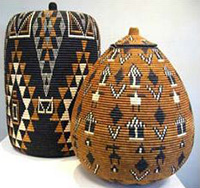 These handmade baskets are very colorful and useful. Similar bags are used throughout the whole African continent. They serve to carry goods, store food and liquids, and even as décor items and ceremonial vessels. Zulu baskets were originally made from natural materials, like palm and grass fibers; today they are often woven from the phone wire. Usually, there is also a lid, woven as well. Various shapes, sizes, colors, and patterns are used to make a Zulu basket. The most popular colors are black, brown, orange, and yellow. The most popular patterns are zig-zags, triangles, diamonds, and squares.
These handmade baskets are very colorful and useful. Similar bags are used throughout the whole African continent. They serve to carry goods, store food and liquids, and even as décor items and ceremonial vessels. Zulu baskets were originally made from natural materials, like palm and grass fibers; today they are often woven from the phone wire. Usually, there is also a lid, woven as well. Various shapes, sizes, colors, and patterns are used to make a Zulu basket. The most popular colors are black, brown, orange, and yellow. The most popular patterns are zig-zags, triangles, diamonds, and squares.
7. Native American bag (territory of modern Us and Canada)
 These bags are made by the Native American Indians. Usually, they’re made from leather (deerskin or elkskin) and embellished with beading, fringe, and decorative elements. Each tribe used to have its own traditions in bag-making: unique design, shape, adornments, purpose, and customs connected with the bag. The pouches were used by the Native Americans to carry goods (as many of the tribes were nomadic), medicine, tobacco, ceremonial items, etc. Such bags were an important part of the folk costume of Native American Indians. Today, they are often made to sell to tourists and to spread the knowledge about the Indian traditions around the world.
These bags are made by the Native American Indians. Usually, they’re made from leather (deerskin or elkskin) and embellished with beading, fringe, and decorative elements. Each tribe used to have its own traditions in bag-making: unique design, shape, adornments, purpose, and customs connected with the bag. The pouches were used by the Native Americans to carry goods (as many of the tribes were nomadic), medicine, tobacco, ceremonial items, etc. Such bags were an important part of the folk costume of Native American Indians. Today, they are often made to sell to tourists and to spread the knowledge about the Indian traditions around the world.
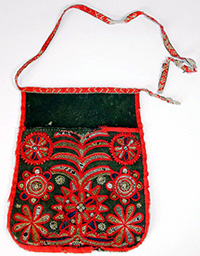 6. Dräktväskor – folk bag (Sweden)
6. Dräktväskor – folk bag (Sweden)
Beautiful waist purses are an important part of a Swedish folk dress. They are small and richly embroidered. Dräktväskor is used as a pocket. Females carry small things in it. These pouches are extremely bright; they are covered with multicolor embroidery. Floral embroidery patterns are the most widespread. Sometimes the bag has a thin strap, in other cases, it is pinned to the skirt or apron. Dräktväskor is usually handmade; it is made from fabric and sometimes decorated with metal elements.
5. Sporran (Scotland)
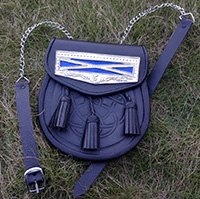 The sporran is an important part of a Scottish male folk outfit. It is a belt-pouch worn with a kilt. The purpose of the sporran is to carry things (since the kilt is pocketless) and to keep the kilt in place. This bag is usually worn in the front, but during running, dancing, driving and other activities the pouch can be turned around the waist to hang on the hip. The sporran is attached to the belt with a help of a leather strap or chain. It can be made from various materials: leather, fur, animal skins, and fabric. The sporrans are usually very fine and embellished with metal decorations, tassels, embossing, etc. Often, men made the sporrans themselves because they wanted unicity.
The sporran is an important part of a Scottish male folk outfit. It is a belt-pouch worn with a kilt. The purpose of the sporran is to carry things (since the kilt is pocketless) and to keep the kilt in place. This bag is usually worn in the front, but during running, dancing, driving and other activities the pouch can be turned around the waist to hang on the hip. The sporran is attached to the belt with a help of a leather strap or chain. It can be made from various materials: leather, fur, animal skins, and fabric. The sporrans are usually very fine and embellished with metal decorations, tassels, embossing, etc. Often, men made the sporrans themselves because they wanted unicity.
4. Chuspa or coca bag (Peru)
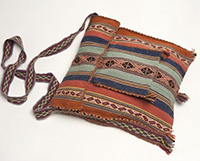 It is a small woven purse used to carry coca and cocoa leaves in the Andean region. Peruvian textile is world-famous, and the chuspa is a great example of local weaving technique. These bags are used in the Andean region for about 1,500 years. Coca and cocoa leaves are used by locals to reduce hunger and quickly get some energy. Also, the leaves play an important role in the ceremonies. The chuspa bag is usually made from alpaca, llama, vicuña, or guanaco wool. Male pouches have thin neck straps, women’s purses are strapless and worn tucked into the waistband of a skirt. The chuspas are very bright and colorful, decorated with the local traditional patterns, pom-poms, fringes, etc.
It is a small woven purse used to carry coca and cocoa leaves in the Andean region. Peruvian textile is world-famous, and the chuspa is a great example of local weaving technique. These bags are used in the Andean region for about 1,500 years. Coca and cocoa leaves are used by locals to reduce hunger and quickly get some energy. Also, the leaves play an important role in the ceremonies. The chuspa bag is usually made from alpaca, llama, vicuña, or guanaco wool. Male pouches have thin neck straps, women’s purses are strapless and worn tucked into the waistband of a skirt. The chuspas are very bright and colorful, decorated with the local traditional patterns, pom-poms, fringes, etc.
3. Yoruba beaded bag (Nigeria)
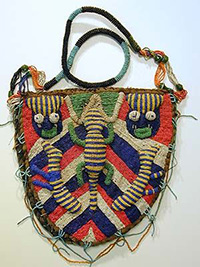 These bags are made by Yoruba people and often used during ceremonies and rituals. For example, priests and diviners carry their tools in such bags. Yoruba beaded bags are real works of art. The bag is usually thoroughly embellished with tiny beads. Moreover, the beading forms intricate patterns and shapes. The most popular patterns are animals, human and animal faces, geometrical shapes, etc. Yoruba beaded bags usually have shoulder straps; these straps can also be adorned with beading. There are also other embellishments on the bags, like tassels, fringe, knotting, etc.
These bags are made by Yoruba people and often used during ceremonies and rituals. For example, priests and diviners carry their tools in such bags. Yoruba beaded bags are real works of art. The bag is usually thoroughly embellished with tiny beads. Moreover, the beading forms intricate patterns and shapes. The most popular patterns are animals, human and animal faces, geometrical shapes, etc. Yoruba beaded bags usually have shoulder straps; these straps can also be adorned with beading. There are also other embellishments on the bags, like tassels, fringe, knotting, etc.
2. Wayuu bag or mochila (Colombia and Venezuela)
 Wayuu bags are made by Wayuu people. The craft of making mochilas is being passed from mother to daughter for hundreds of years. These purses are woven by a crochet. The straps are made by Wayuu men. The patterns and colors are also traditional; the craftswomen know the meaning of every symbol, pattern, and color. Actually, there is an interesting background to the Wayuu bags. Young Wayuu girls start learning how to make mochilas during their first menstrual cycle (in this period, they aren’t allowed to leave their house; for about 6-12 months they contact only with mothers and grandmothers). They are taught everything about the tribal traditions, crafts, and household. Wayuu bags are made and sold to tourists and locals. It helps Wayuu people to earn for living.
Wayuu bags are made by Wayuu people. The craft of making mochilas is being passed from mother to daughter for hundreds of years. These purses are woven by a crochet. The straps are made by Wayuu men. The patterns and colors are also traditional; the craftswomen know the meaning of every symbol, pattern, and color. Actually, there is an interesting background to the Wayuu bags. Young Wayuu girls start learning how to make mochilas during their first menstrual cycle (in this period, they aren’t allowed to leave their house; for about 6-12 months they contact only with mothers and grandmothers). They are taught everything about the tribal traditions, crafts, and household. Wayuu bags are made and sold to tourists and locals. It helps Wayuu people to earn for living.
1. Pasiking (the Philippines)
 It is the traditional Philippine hunter backpack made from the natural materials. The craft of making the pasiking is old and complicated. This construction is intricate and unique; every detail is thought-out. These backpacks are real masterpieces. Every part of the pasiking is woven of bamboo or rattan, including the shoulder straps and the lid. In some cases, the backpack is waterproofed with a help of the fibers of a pineapple plant. Nowadays, this craft is dying out, because modern backpacks factory-produced from synthetic materials became so popular around the world. Filipinos just don’t need to spend so much time on making a bag anymore.
It is the traditional Philippine hunter backpack made from the natural materials. The craft of making the pasiking is old and complicated. This construction is intricate and unique; every detail is thought-out. These backpacks are real masterpieces. Every part of the pasiking is woven of bamboo or rattan, including the shoulder straps and the lid. In some cases, the backpack is waterproofed with a help of the fibers of a pineapple plant. Nowadays, this craft is dying out, because modern backpacks factory-produced from synthetic materials became so popular around the world. Filipinos just don’t need to spend so much time on making a bag anymore.


